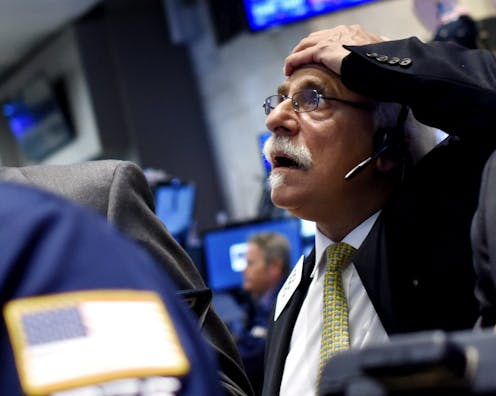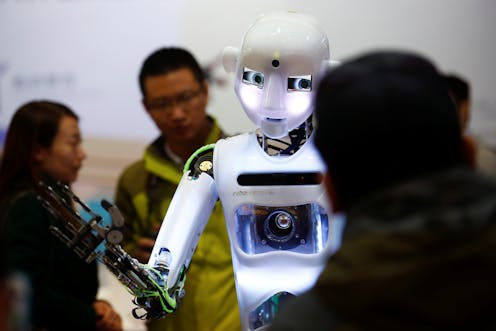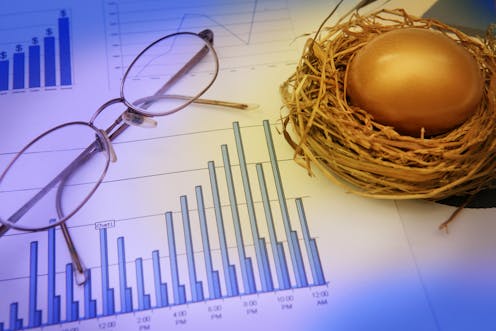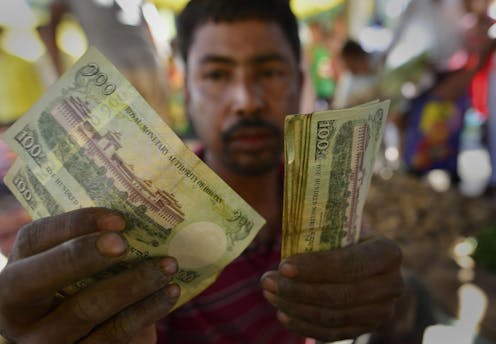
Business Briefing
The Conversation
The Conversation editors, Jenni Henderson and Josh Nicholas, delve into a new topic every week, unearthing the latest business and economic analysis from our best academics.
- 18 minutes 3 secondsWhat happened to the price of Bitcoin? The truth behind big bubbles and crashes
 Justin Lane/AAP
Justin Lane/AAPWhen Katherine Hunt’s dad asked her whether or not he should invest in Bitcoin, alarm bells rang, first she thought “he’s a musician”.
Hunt is a lecturer in accounting at the Griffith Business School, and as someone who knows the five stages of a bubble and crash, she was worried when it seemed everyone was thinking they needed to “get in on” Bitcoin.
“The stock market is a manifestation of the psychology of everyone who is investing, so of course there is going to be these crazy stages,” Hunt says.
There is a boom, as momentum behind a new stock or asset speeds up and the media starts to cover it, fuelling its price rise.
Then the euphoria sets in, the value of the asset skyrockets and people start to make a profit. But looming around the corner is the panic.
Investors feel the last phase of a crash far more than they do the elation of the price rising, Hunt says. Panic breeds more panic and the price falls.
Hunt is seeing this pattern play out with the stocks of the more well known gig economy businesses like Airbnb and Uber. These businesses now enjoy the privilege of being the only, or one of a few of their kind, in the marketplace. But Hunt says this can’t last.
“In an open market that’s not the case at all, there’s always going to be competition and these companies will fall. It’s just probably that they’ll fall in 30 or 40 years, not necessarily tomorrow,” she says.
Of course this is all easier to see in hindsight.
Remembering the global financial crisis
John Crosby, now a senior lecturer in finance at the University of Technology Sydney, was once working as an investment banker at Lloyds of London in 2007 when he noticed a news story on losses financial services company HSBC was reporting from its subprime mortgages.
“I thought, that could be quite bad,” Crosby recalls.
At the time volatility was low and it seemed like everything was going along fine. But Crosby overheard a coworker who looked after the banks’ various branches asking people to move any sums to deposit to London.
“That wasn’t normal right? It was perfectly normal that you did business with anybody you wanted to, unless there was a real credit risk issue with the bank,” he says.
Crosby realises now that his coworker knew other banks were carrying toxic debt that would eventually kick off the global financial crisis.
When it came to 2008 the real problems became clear and it was more of a question of which bank would fall next, he says.
“People were way too complacent before the crisis and then during the crisis it’s one of blind panic, thinking everyday things are going to get worse. Whereas in reality there was light at the end of the tunnel,” Crosby says.
By then Crosby was working at financial services company UBS and thousands of people were being laid off. In 2009 the company decided to hire half of those employees back.
Past theories about what causes crashes
The benefit of hindsight also shows what sort of speculation leads to market crashes. Before crashes were well understood, economists had to grapple with what they thought might be causing a crash.
In the 19th century, economist William Stanley Jevons believed that sunspots (hyperactive radiation on the sun) could be the key to understanding crashes.
“He was interested to find out that the cycle of sunspots was very similar…as the trade cycle back on earth,” says Simon Ville, a professor of economic and business history at the University of Wollongong.
Of course this theory was later discredited, but there have been bubbles over some very ordinary assets in the past.
Ville explains that tulips were at the centre of the first market bubble and crash in recorded history. Tulips became high fashion in the Netherlands, in the early 17th century, but because it took a while for these plants to grow it was very much like the future markets we see today in modern finance.
“That inevitably creates a sense of uncertainty and a sense of speculation, ‘what are you actually buying? Will you get the full value of what you’re paying for?’,” Ville says.
Of course people started paying more and more for tulips, until it took someone’s life savings to buy one bulb. Ultimately there was a point where euphoria turned to panic and the climate changed from optimism to pessimism. This is when the price crashed, and the bubble burst.
 6 December 2017, 7:20 pm
6 December 2017, 7:20 pm - 13 minutes 40 secondsBusiness Briefing: questioning the economics of prison
 The perimeter fence at Silverwater jail in Sydney's west AAP
The perimeter fence at Silverwater jail in Sydney's west AAPThere are more than 41,000 daily full-time prisoners in Australia, according to the latest ABS data. Many of them are in private prisons - almost 20% of the prison population according to a 2014 Productivity Commission report.
But we don’t really know whether private prisons are more cost effective or produce better results. Private prison contracts are often “commercial in confidence”, and it’s hard to know what exactly we’ve paid for. All this means we have to rely on watchdogs to ensure taxpayers are getting value for money, and it’s tough for companies to really compete.
Read more: Private prisons and the Productivity Commission: where is the value for money?
Prison job programs are often touted as a way to reduce prisoner recidivism, but again there is little evidence showing a positive impact. Joanne Wodak was a research assistant on a study in the Northern Territory. Despite positive feedback from both prisoners and employers, Wodak says these programs don’t address other, important factors affecting recidivism such as alcoholism and homelessness.
Technology could drastically change what a prison is and who is in them - through the use of algorithms that decide who gets bail, for instance. But as the University of Sydney’s Sandra Peter and Kai Riemer discuss, it’s unlikely to have an impact on the jobs prisoners themselves do. Low wages mean that prisoners provide an incredibly cheap source of labour, and the economics of this is unlikely to be drastically changed by technology.
 30 October 2017, 7:03 pm
30 October 2017, 7:03 pm - 14 minutes 14 secondsBusiness Briefing: the ‘get rich quick scheme’ influencing what you buy
 Advertising through online influencers is shaping consumer law, business models and people's careers. Nico Aguilera/Flickr, CC BY-SA
Advertising through online influencers is shaping consumer law, business models and people's careers. Nico Aguilera/Flickr, CC BY-SAIt sounds like a get rich quick scheme. Amass huge numbers of followers on a social media platform like Instagram and you can get paid like a celebrity to mention or feature products in your posts.
But this industry of “online influencers” was worth US$500 million in 2015, and is expected to grow to be worth US$5 billion by 2020, according to Sandra Peter from the University of Sydney. There’s a well documented business model behind it.
Even though these online influencers might not be overtly endorsing a product, advertisers will still pay a lot to have something featured, even subtly, in their posts.
The relationship online influencers form with their followers is different to a regular celebrity because they have more leeway to talk about their own experiences. When the influencer industry was at it’s peak, about five years ago, the content was more about using your body or life to sell something, says Crystal Abidin from Curtin University. But this is now changing.
“Today it’s expanded so much that even in the influencer scene there are hierarchies,” she says.
“Big name influencers may not spend as much time investing their own narratives in these products, but they may just do a shout out, that is so impactful that advertisers don’t mind.”
This is indicative of a broader change to professionalism in the industry, where big internet companies like Amazon, Reddit and Youtube are starting influencer offshoots, says Abidin.
With this growing industry consumers are starting to cotton on to the potential of being led astray. For example online influencers were mentioned in a lawsuit against a festival in the United States, where consumers felt their expectations (including those set by prominent online influencers) weren’t met.
“What we saw with the Fyre Festival really does highlight the dangers of the influence that these people wield on social media and if it’s not absolutely made clear that they are promoting something…that has a material effect on consumers,” says David Glance from the University of Western Australia.
While there are laws in Australia to protect consumers in Australia from misleading advertising, Glance says social media platforms need to make it clearer when someone is paid being to promote. He says this should go beyond a hashtag to something written on the post, pointing it out to consumers.
 24 August 2017, 7:19 pm
24 August 2017, 7:19 pm - 16 minutes 41 secondsBusiness Briefing: are our standards dropping in the workplace?
 How should you signal that you don't want to be disturbed? www.shutterstock.com
How should you signal that you don't want to be disturbed? www.shutterstock.comOur workplaces are becoming less formal as the decor resembles what we have at home, companies relax dress codes, and technology makes it possible to work from anywhere.
But the old formality had some advantages, says Libby Sander from Bond University. For example, closed doors used to signal that you didn’t want to be disturbed, and suits are an easy way to look professional.
As Sander points out, new forms of office etiquette, such as not disturbing someone wearing headphones, are filling this void.
To know how to behave in this new relaxed environment, context matters, says Nicole Gillespie, an associate professor of management at the University of Queensland. This means reading the relationships you have with your co-workers and the wider culture in the office, and being aware of the effect you own actions are having.
Never is this more important than in cases of office profanity. It’s not uncommon to hear a bit of swearing in some workplaces, but it could get you fired in certain circumstances. As part of one Fair Work Commission ruling, the difference comes down to swearing in conversation, versus directly at someone.
“There’s a big difference between that coarse kind of conversation and aggression in someone’s tone of voice, so you’ve got to ask what the intention is,” says Simon Burgess, from the University of New England.
Burgess says it’s up to each of us to hone our communication skills and perhaps improve our office etiquette a bit.
 13 July 2017, 8:16 pm
13 July 2017, 8:16 pm - 12 minutes 52 secondsBusiness Briefing: following the money in cricket
 Cricket Australia has been unable to broker a new pay deal with the Australian Cricketer's Association. EPA/DAVID JONES
Cricket Australia has been unable to broker a new pay deal with the Australian Cricketer's Association. EPA/DAVID JONESRather than just admiring a good hit or delivery, there’s another way to analyse what’s happening on a cricket pitch. Cricket players are actually business people, in the sense that they’re weighing up how many resources they have, whether it’s wickets in hand or overs remaining, says Steven Stern, a professor of data science at Bond University.
Stern is responsible for the Duckworth-Lewis-Stern method, which is used to calculate the score, and even who wins, when rain interrupts play. He crunches the numbers on games that have been played since the 1990s, and uses the resources remaining to decide what the score should be.
It’s all about risk and reward, says Stern, and the cost benefit analysis carried out by teams and players.
Technology is also changing the business of cricket. On the one hand it provides a useful tool for players to measure how well they are doing, but it can be a double edged sword, this same data can be used in performance indicators.
Sandra Peter and Kai Riemer from the University of Sydney point to the example of the International Cricket Council which is using sensors on cricket bats. These can help to develop the skills of players in training but it can also be used to gather data on player performance, to decide what they get paid.
Pay is the reason cricketers are currently in a stand-off with their governing body Cricket Australia. The cricketers argue that more needs to be spent at the lower levels of the sport.
Judging by what has happened in other sports like rugby league, if money is not spent on the administration and supporting the lower levels, it starts to shows as cracks in the national level of the sport, says Stephen Frawley from UTS.
 21 June 2017, 8:03 pm
21 June 2017, 8:03 pm - 10 minutes 23 secondsThe science of business decision making: giving out perks doesn’t necessarily lead to results
 Office perks like slides down stairs may not be the best way to motivate good behaviour Scott Beale/Flickr, CC BY-NC-ND
Office perks like slides down stairs may not be the best way to motivate good behaviour Scott Beale/Flickr, CC BY-NC-NDResearch shows that when it comes to cognitive tasks, like decision making, paying people more can lead to worse outcomes. If we want to get the best out of our executives, the ideal amount to pay them is “enough to take money off the table”.
Anything extra might excite them, but not in a way that makes them better executives. Put simply, giving a CEO one, two or three million dollars might motivate them. But it doesn’t necessarily follow that they will work any harder if offered four, five or six million.
That’s because they don’t really need the sixth million. It does not provide upside motivation, and could have the reverse effect. Research shows when you have enough money then you value the next dollar less, and may not work as hard for it.
There are other motivations that drive performance, such as the prestige of a particular company or job. Paying someone less may lead to better outcomes when they are motivated by these other factors.
In practice, if we want the best decision making, this means we should pay executives enough so they feel rewarded for their efforts, but no more than others would take to do the same job, says associate professor Prabhu Sivabalan.
Hear more on what professor Prabhu Sivabalan has to say on decision making, also what Game Theory has to say about the decisions that lie behind where businesses set up shop with academic Stephen Woodcock, in this edition of Business Briefing.
 22 May 2017, 7:59 pm
22 May 2017, 7:59 pm - 13 minutes 29 secondsBusiness Briefing: how the attitudes of the next generation are changing the property market
 Generation X and Y are equally, if not more aggressive than baby boomers when investing in property. Chris Devers/Flickr, CC BY-NC-ND
Generation X and Y are equally, if not more aggressive than baby boomers when investing in property. Chris Devers/Flickr, CC BY-NC-NDGenerations X and Y are becoming just as, or even more aggressive, than the baby boomers as investors. An example of this are the “rentvestors”, who still don’t live in their own home, but have an investment property.
There’s been a change in culture over the generations when it comes to the property market, says researcher Ilan Wiesel from the University of Melbourne.
“It’s the shift from housing as a home, as a right, to housing as a commodity,” he says.
This is reflected in that 60% of household wealth is in people’s homes. But for younger people, like Generation Y, there are some who choose to move around for work so tying themselves to one location doesn’t have the same appeal.
Looking at the baby boomers, there are two types of security that drive people’s feelings about property. One is a sense of financial security but another is tied to a sense of continuity, in knowing you have a home and how that affects your identity.
If you look at the advertisements for properties through the generations, certain aspects of these changing ambitions are highlighted, says researcher Robert Crawford from the University of Technology Sydney.
After the war and the great depression, people felt hard done by and that it was time for a reward, that reward was owning a home.
“The advertisements really play on this, but it’s a dream,” says Crawford.
In the advertisements of the 1980s this changed again as size and location of properties became more of a feature than just owning a home.
“As more and more people begin to realise their dreams of home ownership, the next [point] is - owning a home isn’t as much of an achievement, so I'II have to own a particular size of home,” Crawford adds.
The rental market is also changing with generations, as more renters have a high income and rent for longer, says Professor Kath Hulse from the Swinburne University of Technology.
In comparing this to other countries, Hulse says there is a culture of treating tenants differently too.
“Germany has a very stable rental system… there’s a lot more security of tenure and it’s very common if someone sells the house, to sell it with the tenant, they don’t have to get out.”
“Whereas in our case it’s almost automatically assumed that if you buy a house with a tenant or if you want put your house on the market, the first thing you do is to ask the tenant to leave,” she says.
Over time some policies, like the First Home Buyers Grant, have had some impact on changing the behaviour of people in relation to the property market but with the danger of a flow on rise in house prices.
“Part of it is to make the rental sector a better place to live, with better more modern regulation and better quality of service… and then people might have a real choice as to what they want, rather than feeling like they have to move into home ownership,” Hulse says.
 14 March 2017, 7:14 pm
14 March 2017, 7:14 pm - 12 minutes 56 secondsBusiness Briefing: when robots and customers meet
 Customer-facing roles may soon be taken over by cheaper, friendlier and more knowledgeable robotic retail assistants. Thomas Peter/Reuters
Customer-facing roles may soon be taken over by cheaper, friendlier and more knowledgeable robotic retail assistants. Thomas Peter/ReutersWhen you call up a business, you might get an automated customer service giving you options and helping you to do whatever it is you need to. This is a digital robot.
It’s common to see digital robots in these types of roles because the technology is getting cheaper and better, says Mary-Anne Williams, founder and director at UTS’ Innovation and Enterprise Research Lab.
Williams researches how humans interact with different types of robots, in customer service roles. She says because digital robots can access vast amounts of data about certain customers, these bots can provide a more specialised and customised service, similar to that of the good old days.
People have fewer problems dealing with digital robots than humans because machines don’t make emotional or ethical judgements about customers that make them uncomfortable.However, when it comes to physical robots in customer service roles, our reactions can be very different. In research on these robots, there is a concept called “the uncanny valley”. This is where the closer the robot is to human form or face, the more uncomfortable or eerie we feel. So there’s that to overcome.
Experiments students at Williams’ lab have conducted in a shopping mall show that these physical robots have to work hard to attract our attention and we’re easily underwhelmed by them, compared to the ones we see on TV or movie screens.
The next big frontier for physical robots in business is to get them to empathise with customers, to understand the context around questions and interactions. And with the speed of innovation, this may be closer than we think, Williams says.
The business briefing podcast will return with a new format in 2017. If you’ve got any feedback you’d like to pass on, please email it to: [email protected]
 14 December 2016, 6:01 am
14 December 2016, 6:01 am - 7 minutes 16 secondsBusiness Briefing: what super is doing to banking and finance
 Superannuation's influence on the Australian financial sector mostly balances out. www.shutterstock.com
Superannuation's influence on the Australian financial sector mostly balances out. www.shutterstock.comThe total of superannuation assets in Australia is a staggering A$2 trillion and contributions to this are rising. But despite this significant influence, a new study shows the effects of superannuation on banking and finance mostly balance out.
A researcher who was presenting the study, Robert Waschik from the Centre of Policy Studies in Melbourne, says the study found super funds hold more offshore assets than most households, so any increase in the guarantee for superannuation would increase demand for foreign assets leading to some depreciation in the Australian dollar. However this could be offset by the Reserve Bank raising interest rates, he notes.
Another aspect of the study tried to see whether the common gripe of bankers that an increase in superannuation could reduce the banks’ access to capital (through bank customers) could actually happen. The modelling found the banks could access more money through a few other measures, the study showed, including equity and bonds.
Waschik says the modelling points to potential threats to financial stability through an increase in the debt to equity and debt to income ratios of households, though these should be balanced out by a deepening of the market for corporate bonds in banking and strengthening of the current accounts balance.
 7 December 2016, 10:23 pm
7 December 2016, 10:23 pm - 16 minutes 13 secondsBusiness Briefing: Former chief World Bank economist on inequality and doing away with big money
 The Modi government is getting rid of RS500 and RS1,000 notes to try and combat the black market and corruption. STR/EPA
The Modi government is getting rid of RS500 and RS1,000 notes to try and combat the black market and corruption. STR/EPADoing away with big currency notes is a movement that is picking up all over the world, says Kaushik Basu, a professor of economics at Cornell University. While it may be a good idea in theory for tackling tax evasion and the black market in Australia, he says policymakers have to be cautious in implementing it.
Basu, a former economic adviser to the Indian government and chief economist at the World Bank, says the policy is an ineffective tool in India.
India’s Modi government recently decided to demonetise RS500 and RS1,000 notes, giving citizens until December 31 to change them. It was designed to target corruption, the black market and tax evasion, but Basu says it could potentially hamper the country’s growth and have a disproprtionate negative effect on the poor and lower middle class.
Basu also weighed into the ongoing debate on addressing inequality in various economies around the world while still looking for economic growth. While growth is still important for economies catching up like India, some growth can be sacrificed to redistribute profit, he notes.
He argues policymakers, including in Australia, need to stop tinkering around the edges and come up with big ideas. Basu uses the example of profit sharing, where a pool of some share of all profits, for example 10%, goes straight to the workers.
Also in this podcast, economist Richard Holden answers a question about Trump’s borrowing in business and in government for Ask an Economist.
If you’ve got a burning economics question you’d like to ask, write it down or record it and send it to [email protected] – and be sure to include your name and where you’re from.
 30 November 2016, 5:21 am
30 November 2016, 5:21 am - 14 minutes 19 secondsBusiness Briefing: fixing culture in banking and finance
 Commonwealth Bank of Australia CEO Ian Narev attends the parliamentary inquiry into the banking system. AAP Image/Lukas Coch
Commonwealth Bank of Australia CEO Ian Narev attends the parliamentary inquiry into the banking system. AAP Image/Lukas CochAustralian banks have been under intense scrutiny this year after various scandals called into question the culture of the industry. But it seems there’s no easy answer to improving culture.
Professor Paul Kofman from Melbourne University was a panellist at an event discussing this exact issue. He says the heart of the problem is the lack of evidence for what types of cultural interventions translate into good business outcomes.
Kofman says bank executives can’t ignore culture anymore because their jobs are on the line, but he also notes they aren’t trained sociologists, so they might not notice problems in culture when they occur.
Instead of looking at the conduct of employees when trying to improve culture, the focus should instead be on the customer and if they are being best served, most of the panellists at the event agreed.
In an industry that has changed a lot over time, Kofman isn’t convinced “big data” on its own will necessarily provide deeper insights into bank culture. He says as long as we’re not sure how to measure culture, having more observations won’t help. Kofman notes much of the exciting data analytics are in fact generated by new financial operators (for example in financial technology and offshore operators) that are currently outside the scope of our regulators.
Also on the podcast this week, Richard Holden tackles a question about how low borrowing rates affect demand and investment for Ask an Economist.
 22 November 2016, 7:27 pm
22 November 2016, 7:27 pm - More Episodes? Get the App
Your feedback is valuable to us. Should you encounter any bugs, glitches, lack of functionality or other problems, please email us on [email protected] or join Moon.FM Telegram Group where you can talk directly to the dev team who are happy to answer any queries.
 Change Agents
Change Agents
 Trust Me, I'm An Expert
Trust Me, I'm An Expert
 In Depth, Out Loud
In Depth, Out Loud
 Essays On Air
Essays On Air
 Media Files
Media Files
 Speaking with...
Speaking with...